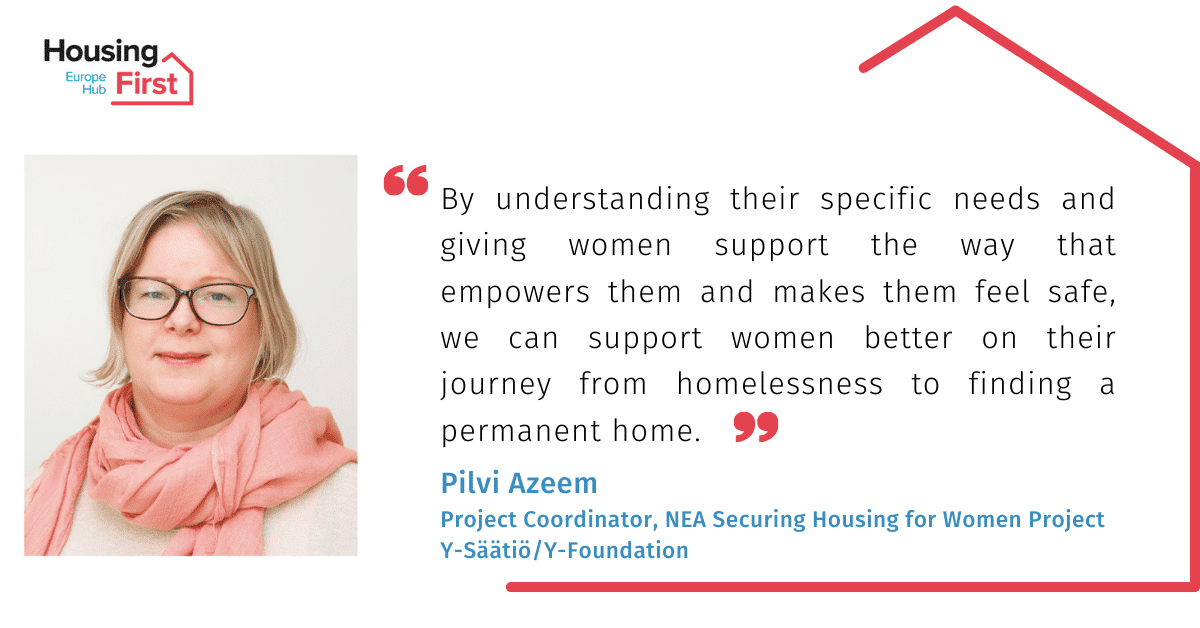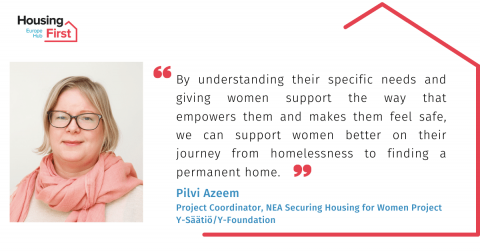
In this blog, I mainly focus on women who are marginalized in many areas of their lives and experiencing homelessness is only one part of it. This inspiration for this article is based on the publication Kohti kotia ja turvaa which was released by the NEA Securing Housing for Women Project in 2020.
Homelessness has decreased in Finland year-by-year, and the launch of Housing First as a national program to end homelessness has been especially important in achieving this. But at the same time, the percentage of women experiencing homelessness has increased. While ten years ago, 1 out of 5 homeless people were female, now over 25% of homeless population in Finland are women. This was one of the reasons why NEA’s Securing Housing for Women project was started in 2018
The main goal of theNEA Securing Housing for Women Project has been to end women´s homelessness and to be able to achieve this target it has needed strong co-operation between organizations working in the homelessness sector and in women-specific fields.
In the NEA Securing Housing for Women Project, co-work has been done by professionals with knowledge and experience of homelessness, substance misuse, mental health, violence and family work. Workers with lived experience have had a significant role as well in helping to ensure that the voices of service users are heard.
And what have we found out so far? Not least I can say that with the NEA Securing Housing for Women Project we have been able to make it very clear that there is a need for gender sensitivity in the homelessness sector and to be able to end homelessness we need to make sure that the specific needs of different genders are being met. So if we want to end women´s homelessness and we want to use Housing First as a tool to achieve that target, we do need to find out the specific needs women experiencing homelessness have and adjust our services based on these findings.
It’s important to start by understanding that there is not just one category of women experiencing homelessness.
There are some women-specific factors that should be taken into account when planning and performing homeless services for women. Some women only need a flat, while others have multiple needs that require more diverse types of support.
To be able to understand and to do women-specific work in the homeless sector, people working with homeless women have to understand the very diverse needs of these women, as well as their life histories and situations they live in at the moment.
Common for women experiencing homelessness is that their problems are often connected in some way to their close relationships. They might have lost their home because of a violent partner or someone close to them has stolen their rent money. They feel ashamed and stigmatized. They are ashamed of losing their home or that their children have been taken into custody. Homeless women also very often experience violence or abuse. They might flee from domestic abuse and then face further abuse on the streets because they are in a minority and often the most vulnerable group amongst homeless people. The service system may also be organized in such a way that women experiencing homelessness don´t feel safe to seek help through registered services, or otherwise they don´t find the help they are looking for in line with their needs. Another question is how a homeless woman can take care of her femininity and hygiene while living on the street.
These multiple experiences of violence can often expose one being traumatized. Women experiencing homelessness can be traumatized on many levels due to their marginalized status in homelessness field. This vicious cycle leads to various support needs and lack of trust towards other people and society, including offered support.
When planning suitable services and housing solutions for homeless women the focus has to be on creating safety.
Maybe in Housing First we could call it Safety First for women! And by safety, we mean both physical and psychological safety. To have a safe environment for homeless women can mean, for example, offering women-only spaces or service times allocated only for women. When supporting women experiencing homelessness the key to making women feel safe is to spend time with them and slowly build a trustworthy relationship by meeting their multiple needs.
Workers with their own lived experience can be extremely helpful when building relationships with service users. They may be in a better position to gain trust with service users by sharing common experiences of homelessness. When housing homeless women, time also has to be spent on finding out where and how they can feel safe. To prevent homelessness and support women in maintaining their housing, support work needs to focus on helping them to feel at home, help them to settle into their own safe place – in the form of a flat or house – where they can feel secure and comfortable.
Housing First has really developed homelessness work and many people now have a place they can call home. But to make Housing First work even better, it is important to include women-specific work in it and create new housing solutions, especially increasing the availability of services that meet women´s needs. It requires workers to understand women´s multiple needs, their trauma experiences and feelings of shame and guilt. It also requires wide understanding of women´s roles and status in society and the kinds of support women need for them to feel safe.
Social relationships have significant role in women-specific work, also in homelessness sector. This can be ethically very demanding and emotionally tiring for support workers. That is why it is important to have regular counselling and other supports available to them.
By understanding their specific needs and giving women support the way that empowers them and makes them feel safe, we can better support women on their journey from homelessness to finding a permanent home.
Pilvi Azeem
About the Author
Pilvi Azeem is currently working as a project coordinator for the NEA Securing Housing for Women Project, which aims to stop women´s homelessness by securing their housing pathways. The project consists of eight multidisciplinary sub-projects and the main target is to enable these sub-projects to work together and create woman-spesific work methods in the homelessness work field. Pilvi is also an experienced trainer, certified by the Housing First Europe Hub’s ‘Train-the-Trainer programme and speaks Finnish and English.
